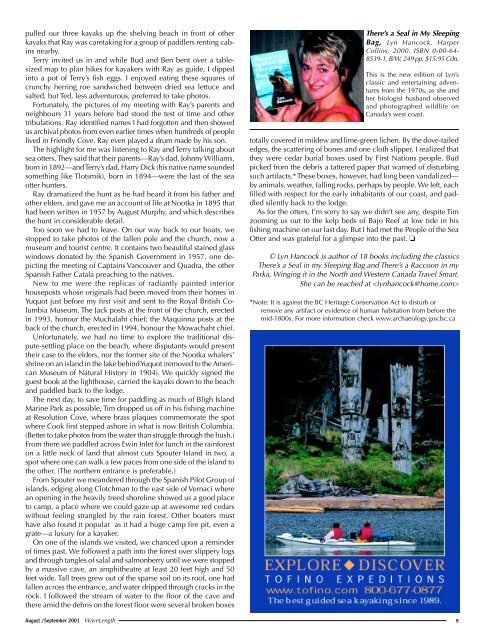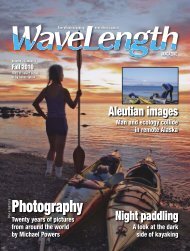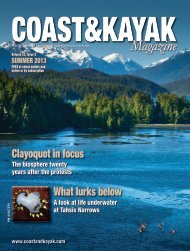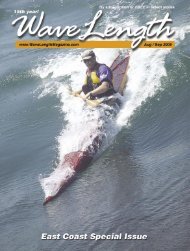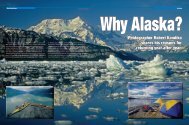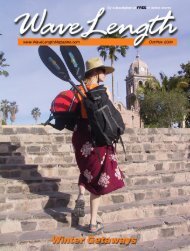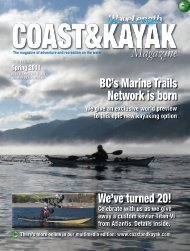You also want an ePaper? Increase the reach of your titles
YUMPU automatically turns print PDFs into web optimized ePapers that Google loves.
pulled our three kayaks up the shelving beach in front of otherkayaks that Ray was caretaking for a group of paddlers renting cabinsnearby.Terry invited us in and while Bud and Ben bent over a tablesizedmap to plan hikes for kayakers with Ray as guide, I dippedinto a pot of Terry’s fish eggs. I enjoyed eating these squares ofcrunchy herring roe sandwiched between dried sea lettuce andsalted, but Ted, less adventurous, preferred to take photos.Fortunately, the pictures of my meeting with Ray’s parents andneighbours 31 years before had stood the test of time and othertribulations. Ray identified names I had forgotten and then showedus archival photos from even earlier times when hundreds of peoplelived in Friendly Cove. Ray even played a drum made by his son.The highlight for me was listening to Ray and Terry talking aboutsea otters. They said that their parents—Ray’s dad, Johnny Williams,born in 1892—and Terry’s dad, Harry Dick (his native name soundedsomething like Tlotsmik), born in 1894—were the last of the seaotter hunters.Ray dramatized the hunt as he had heard it from his father andother elders, and gave me an account of life at Nootka in 1895 thathad been written in 1957 by August Murphy, and which describesthe hunt in considerable detail.Too soon we had to leave. On our way back to our boats, westopped to take photos of the fallen pole and the church, now amuseum and tourist centre. It contains two beautiful stained glasswindows donated by the Spanish Government in 1957, one depictingthe meeting of Captains Vancouver and Quadra, the otherSpanish Father Catala preaching to the natives.New to me were the replicas of radiantly painted interiorhouseposts whose originals had been moved from their homes inYuquot just before my first visit and sent to the Royal British ColumbiaMuseum. The Jack posts at the front of the church, erectedin 1993, honour the Muchalaht chief; the Maquinna posts at theback of the church, erected in 1994, honour the Mowachaht chief.Unfortunately, we had no time to explore the traditional dispute-settlingplace on the beach, where disputants would presenttheir case to the elders, nor the former site of the Nootka whalers’shrine on an island in the lake behind Yuquot (removed to the AmericanMuseum of Natural History in 1904). We quickly signed theguest book at the lighthouse, carried the kayaks down to the beachand paddled back to the lodge.The next day, to save time for paddling as much of Bligh IslandMarine Park as possible, Tim dropped us off in his fishing machineat Resolution Cove, where brass plaques commemorate the spotwhere Cook first stepped ashore in what is now British Columbia.(Better to take photos from the water than struggle through the bush.)From there we paddled across Ewin Inlet for lunch in the rainforeston a little neck of land that almost cuts Spouter Island in two, aspot where one can walk a few paces from one side of the island tothe other. (The northern entrance is preferable.)From Spouter we meandered through the Spanish Pilot Group ofislands, edging along Clotchman to the east side of Vernaci wherean opening in the heavily treed shoreline showed us a good placeto camp, a place where we could gaze up at awesome red cedarswithout feeling strangled by the rain forest. Other boaters musthave also found it popular as it had a huge camp fire pit, even agrate—a luxury for a kayaker.On one of the islands we visited, we chanced upon a reminderof times past. We followed a path into the forest over slippery logsand through tangles of salal and salmonberry until we were stoppedby a massive cave, an amphitheatre at least 20 feet high and 50feet wide. Tall trees grew out of the sparse soil on its roof, one hadfallen across the entrance, and water dripped through cracks in therock. I followed the stream of water to the floor of the cave andthere amid the debris on the forest floor were several broken boxesAugust /September 2001 WaveLengthThere’s a Seal in My SleepingBag, Lyn Hancock, HarperCollins, 2000. ISBN 0-00-64-8539-1, B/W, 249 pp. $15.95 Cdn.This is the new edition of Lyn’sclassic and entertaining adventuresfrom the 1970s, as she andher biologist husband observedand photographed wildlife onCanada’s west coast.totally covered in mildew and lime-green lichen. By the dove-tailededges, the scattering of bones and one cloth slipper, I realized thatthey were cedar burial boxes used by First Nations people. Budpicked from the debris a tattered paper that warned of disturbingsuch artifacts.* These boxes, however, had long been vandalized—by animals, weather, falling rocks, perhaps by people. We left, eachfilled with respect for the early inhabitants of our coast, and paddledsilently back to the lodge.As for the otters, I’m sorry to say we didn’t see any, despite Timzooming us out to the kelp beds of Bajo Reef at low tide in hisfishing machine on our last day. But I had met the People of the SeaOtter and was grateful for a glimpse into the past. ❏© Lyn Hancock is author of 18 books including the classicsThere’s a Seal in my Sleeping Bag and There’s a Raccoon in myParka, Winging it in the North and Western Canada Travel Smart.She can be reached at *Note: It is against the BC Heritage Conservation Act to disturb orremove any artifact or evidence of human habitation from before themid-1800s. For more information check www.archaeology.gov.bc.ca9


